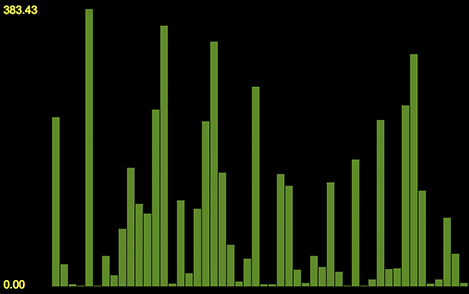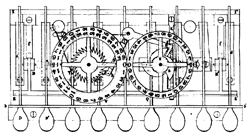Each essay in Group Theory in the Bedroom is followed by a section of “afterthoughts,” where I bring matters up to date, pass along comments from readers, and correct mistakes. This page of the web site is meant to serve the same purpose for the book itself. (The title might properly be Afterafterthoughts.)
From time to time I’ll post updates here, including feedback from readers. Please send all comments, questions, and corrections to Brian Hayes, brian@bit-player.org.
Following the Money, Online
Joseph P. Weinman of AT&T has created an interactive, graphic simulation of the “yard-sale model” discussed in Chapter 3, “Follow the Money.” You can choose the number of traders, the initial wealth distribution and other parameters, then watch the fortunes of the players evolve as trading proceeds. Weinman has also implemented a variant model of his own devising in which players trade with a central banker or market rather than with one another. (And his web site includes a number of simulations on other themes, unrelated to my book, that may also interest readers.)

Following the Money, Carefully
A reader who took the initiative to write his own version of some programs from the book has discovered an error in Chapter 3, “Follow the Money.” Bernardo Kulnig Pagnoncelli of Universidad Adolfo Ibaņez in Santiago, Chile, implemented the “yard sale” algorithm, which traces the distribution of wealth in a population of random traders. Pagnoncelli found that his graphs of wealth distribution agreed in general shape with those shown on page 45 of Group Theory in the Bedroom, but there was a numerical discrepancy. Running his program for 104 (or 10,000) transactions yielded the curve that I had labeled 105 (or 100,000). And after 105 transactions he saw the curve I labeled 107 (10,000,000).
Pagnoncelli’s findings are correct: The labeling of the curves in the book is wrong. A version of the illustration with a color code that gives the correct numbers is shown below.

In the original magazine version of these graphs the curves had been unlabeled. I added the labels while preparing the figure for book publication, and misinterpreted some numbers mentioned in the caption. (Correction posted 24 June 2009.)
Schwilgue’s adding machine
The hero of “Clock of Ages,” the first of the essays in Group Theory in the Bedroom, is Jean Baptiste-Sosimé Schwilgué, who rebuilt the clock of the Strasbourg cathedral 150 years ago. He is introduced via the following anecdote:
Early in the nineteenth century, the story goes, a beadle was giving a tour of the cathedral, and mentioned that the clock had been stopped for twenty years and no one knew how to fix it. A small voice piped up: “Iwill make it go!” The boy who made this declaration was Jean Baptiste-Sosimé Schwilgué, who made good on his promise forty years later.

The story of Schwilgué’s renovation of the cathedral clock is all I had known of his life, but a few weeks ago—too late to revise the chapter—another aspect of his career came to light. It turns out he also built an adding machine, the earliest model known to be driven by typewriter-like keys similar to those of a modern calculator. Schwilgué and his son Charles patented the device in 1844. The patent apparently went unnoticed until 2003, when it was discovered by Denis Roegel of the University of Nancy. Roegel describes the machine in “An early (1844) key-driven adding machine,” IEEE Annals of the History of Computing, Vol.30, No. 1, January–March 2008, pages 59–65.
